
Command reference
R&S
®
ZNL/ZNLE
978
User Manual 1178.5966.02 ─ 19
Note:
It is not possible to disable flatness calibration (see
on page 976) and reference receiver calibration
simultaneously.
Parameters:
<Boolean>
Disables (OFF|1) or enables (ON|1) reference receiver calibra-
tion.
*RST:
ON|1
Example:
See
SOURce:POWer:CORRection:COLLect:FLATness
SOURce:POWer:CORRection:TCOefficient...
These commands allow you
The "Power Meter Transmission Coefficients" dialog allows you to modify the results of
a scalar power calibration to account for additional two-port devices (with known trans-
mission characteristics) in the test setup.
SOURce<Ch>:POWer<PhyPt>:CORRection:TCOefficient:CALibration
<Boolean>
Selects the position of the additional two-port in the test setup.
Note
that it is possible to have two-ports at both positions (see
CORRection:TCOefficient[:STATe]
). This command is kept for compatibility rea-
sons.
Suffix:
<Ch>
.
Calibrated channel number. This parameter is ignored; the trans-
mission coefficient settings are valid for all channels.
<PhyPt>
Calibrated port number. This parameter is ignored; the transmis-
sion coefficient settings are valid for all sources.
Parameters:
<Boolean>
ON
–
two port at power meter (during calibration)
OFF
–
two port at DUT (during measurement)
*RST:
ON (notice that the correction is switched off after a
reset)
Example:
RST; :SOUR:POW:CORR:TCO:CAL OFF
Select the test setup with the additional two-port in front of the
DUT.
SOUR:POW:CORR:TCO:DEF 1GHz, -5; DEF 2GHz, -10;
DEF2?
Define two points in the power loss list; query the second point.
SOUR:POW:CORR:TCO:INS2 1.5 GHz, -7.5
Insert a third point as point no. 2 in the list.
VNA command reference
















































